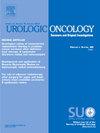Repeat TURBT for Ta and T1 bladder cancer: An updated review
IF 2.3
3区 医学
Q3 ONCOLOGY
Urologic Oncology-seminars and Original Investigations
Pub Date : 2025-08-05
DOI:10.1016/j.urolonc.2025.07.007
引用次数: 0
Abstract
Purpose
The objective of this study is to determine residual tumor characteristics for high grade Ta and T1 bladder tumors following transurethral resection of bladder tumor (TURBT) at a facility where initial aggressive resection is standard.
Methods
This is a retrospective review of patients who had multiple TURBTs done by 2 urologic oncologists at a single facility. During a 5-year period from 2018 to 2022 using specific ICD-10 and CPT codes, the institutional electronic health record was used to identify patients requiring repeat resection for high grade Ta and all T1 bladder cancer. Data compilation and statistical analysis was performed on points of interest from initial to repeat resection, most notably, tumor upstaging and tumor persistence while accounting for multiple demographic variables.
Results
Analysis of our institutional data indicates 143 patients who underwent an initial and repeat TURBT at our facility during the 5-year period of interest. Retrospective data demonstrates a tumor persistence rate of 27.7% and 34.6% for Ta and T1 bladder cancer, respectively. Additionally, our data reveals an upstaging rate of only 3.1% and 3.8% for Ta and T1 bladder cancer, respectively.
Conclusion
Per current American Urological Association (AUA) guidelines, patients with T1 or high-grade Ta bladder cancer should undergo repeat transurethral resection within 6 weeks as previously published literature reports high rates of tumor upstaging and progression. Our data shows a dramatically lower rate of tumor persistence and tumor upstaging on repeat TURBT compared to historical literature, and our surgical approach could potentially challenge the need for repeat resection for certain patients.
重复TURBT治疗Ta和T1膀胱癌:一项最新综述。
目的:本研究的目的是确定经尿道膀胱肿瘤切除术(turt)后高级别Ta和T1膀胱肿瘤的残留肿瘤特征,该设施最初的积极切除是标准的。方法:这是一项由2名泌尿肿瘤学家在同一家医院进行多次turbt的患者的回顾性研究。在2018年至2022年的5年期间,使用特定的ICD-10和CPT代码,使用机构电子健康记录来识别需要重复切除高级别Ta和所有T1膀胱癌的患者。数据汇编和统计分析是在从初始到重复切除的兴趣点上进行的,最值得注意的是,肿瘤晚期和肿瘤持久性,同时考虑到多种人口统计学变量。结果:我们的机构数据分析显示,在5年的研究期间,143名患者在我们的机构接受了首次和重复TURBT。回顾性数据显示,Ta和T1膀胱癌的肿瘤持续率分别为27.7%和34.6%。此外,我们的数据显示,Ta和T1膀胱癌的抢先期率分别仅为3.1%和3.8%。结论:根据目前的美国泌尿学会(AUA)指南,T1级或高级别膀胱癌患者应在6周内进行重复经尿道切除术,因为先前发表的文献报道了肿瘤的高分期和进展率。我们的数据显示,与历史文献相比,重复turt的肿瘤持续率和肿瘤晚期率显著降低,我们的手术方法可能会挑战某些患者重复切除的需要。
本文章由计算机程序翻译,如有差异,请以英文原文为准。
求助全文
约1分钟内获得全文
求助全文
来源期刊
CiteScore
4.80
自引率
3.70%
发文量
297
审稿时长
7.6 weeks
期刊介绍:
Urologic Oncology: Seminars and Original Investigations is the official journal of the Society of Urologic Oncology. The journal publishes practical, timely, and relevant clinical and basic science research articles which address any aspect of urologic oncology. Each issue comprises original research, news and topics, survey articles providing short commentaries on other important articles in the urologic oncology literature, and reviews including an in-depth Seminar examining a specific clinical dilemma. The journal periodically publishes supplement issues devoted to areas of current interest to the urologic oncology community. Articles published are of interest to researchers and the clinicians involved in the practice of urologic oncology including urologists, oncologists, and radiologists.

 求助内容:
求助内容: 应助结果提醒方式:
应助结果提醒方式:


